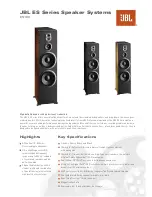
96
ENG/MASTER 98
97
Troubleshooting/Terms
Terms
Dolby Digital
Dolby Digital provides discrete multichannel (up to a maximum of 5.1) audio. This is the same
audio system as is installed in movie theaters.
To enjoy Dolby Digital sound you need to connect this product’s optical digital input to the digital
output on a DVD player with Dolby Digital decoding capability.
1
Dolby Surround Pro Logic
When you play a 2-channel audio disc marked Dolby Surround Pro Logic using an AV amplifier
equipped for Dolby Pro Logic, the audio is converted into 4-channel audio.
Dolby Pro Logic gives enhanced spatial and directional effects, creating theater-like sense of pres-
ence and ambience.
5
DTS for Digital Theater Surround
DTS differs from Dolby Digital, providing a maximum of 6-channel discrete multichannel audio.
To hear DTS discs, you need to connect the digital output on DTS-capable DVD players and other
units to this product’s digital input.
Dynamic Range Control
Dolby Digital has a function for compressing the difference between the loudest and softest
sounds: Dynamic Range Control. This control ensures sounds with an increased dynamic range
are heard clearly even at low volume levels.
Linear PCM (LPCM) /Pulse Code Modulation
This is a recording technology used on music CDs. Some DVD-Video discs also contain PCM
sound tracks. While music CDs are recorded at 44.1 kHz/16 bits, DVD-Video discs’ sound tracks
are recorded at 48 kHz/16 bits to 96 kHz/24 bits, thereby offering better quality audio than music
CDs.
Optical Digital Input
By receiving optical digital input audio signals in a digital signal format, the chance is minimized
that the sonic quality deteriorates in the course of transmission. An optical digital input is an input
designed to receive digital signals optically. (To take advantage of the digital input, output units
such as DVD players must have optical outputs.)
CRB1585A/Eng/066-097 08-06-2000 14:51 Page 97
















































